Ammonia has high potential as a green hydrogen carrier
Renewable energy from wind or solar panels can be erratic, requiring considerable storage capacity to even out supply. Hydrogen-rich ammonia is easy to transport and to store long term in large amounts. This makes it a potential carrier for green hydrogen for use in electric vehicles and power generation, and as a possible fuel for internal combustion engines and solid oxide fuel cells for power generation. Ammonia is carbon-free. “That means you can develop ammonia and transport it, and later when you crack it, it does not emit carbon dioxide into the atmosphere,” explains ARENHA(opens in new window) project coordinator José Luis Viviente, who also serves as project manager and senior researcher at TECNALIA(opens in new window), a technology development centre in Spain. “We successfully showed that ammonia can be used as a hydrogen carrier,” says Viviente. The project also developed several novel prototypes. “We covered the whole value chain at different levels – power from renewables to ammonia-to-usage. We demonstrated innovative technologies for hydrogen production, ammonia synthesis and ammonia cracking with potential applications in mobility, power generation, industry and renewable energy integration,” he explains.
Ease of ammonia transport and storage
“Ammonia is used to produce fertilisers, so it is already known in the industry,” notes Viviente. “The infrastructure to store and transport it is known, but we need to move to green ammonia production.” Ammonia transportation and storage has an advantage over hydrogen – ammonia is liquid around minus 35 degrees at standard atmospheric pressure but liquid hydrogen needs to be around minus 253 degrees below room temperature making it more difficult to transport. “But, via ammonia, green hydrogen can be produced in locations with low-cost renewable energy and transported to other countries. Or you can bring the ammonia to places where you don’t have piping to transport hydrogen,” he says.
Successfully developing electrolyser prototypes
The project developed prototypes of two kinds of solid oxide electrolyser. “We were able to improve the properties, modifying the microstructure and materials, reducing the power needed to produce a fixed amount of hydrogen,” remarks Viviente. This enabled one of the prototypes to be transferred to Nucera(opens in new window), a leading provider of green hydrogen technologies, for development of larger-scale production for the market.
Ammonia synthesis prototype
A third prototype for ammonia synthesis, producing 10 kg of ammonia per day, was built but not tested due to project delays caused by COVID-19 and material supply issues. It nonetheless gathered important information. According to Viviente: “The new ammonia synthesis loop uses a new configuration and materials that can allow us to produce ammonia at milder conditions than existing commercial systems.”
Ammonia cracking prototype
A new concept was demonstrated for ammonia cracking – the chemical decomposition of ammonia to yield high-purity hydrogen gas. “The novel process uses a catalytic membrane reactor to work at lower temperatures, compared to the standard cracking system,” adds Viviente. This concept has been demonstrated in other chemical processes studied in previous EU-funded projects such as DEMCAMER and ReforCELL in which reaction and separation are combined in a single-unit catalytic membrane reactor. “When integrating membranes into the reactor, the decomposition and separation of hydrogen are carried out simultaneously in the same location, increasing the ammonia decomposition compared to a conventional process,” he notes. “This reduces the number of steps to just one step.” “It also lowers the very high temperatures at which cracking occurs, slashing costs and reducing the energy footprint.”







